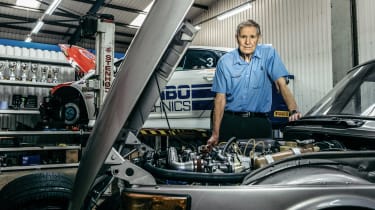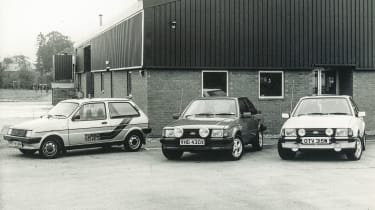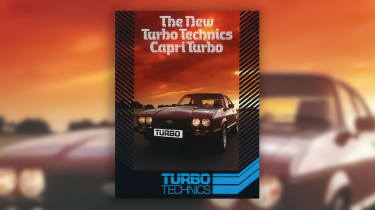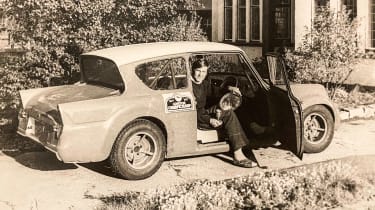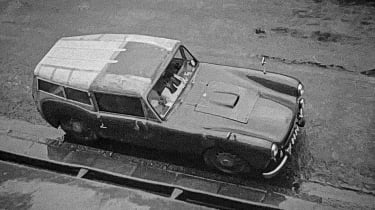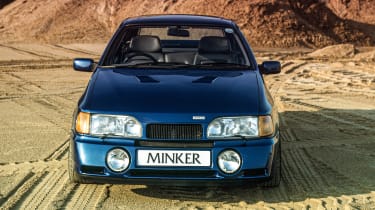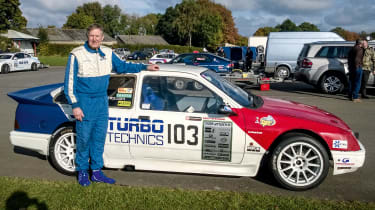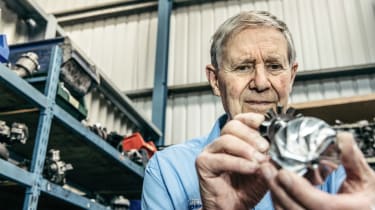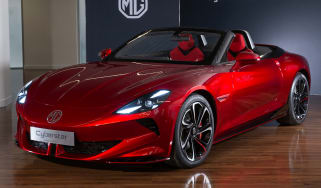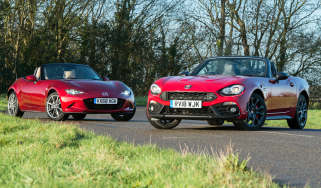My Life & Cars – Geoff Kershaw, turbocharging pioneer
Part of the team that developed the Saab 99 Turbo, Geoff Kershaw went on to found Turbo Technics and create a host of performance icons of the original turbo era
In 1975, Geoff Kershaw took a flight to Sweden. In his hand luggage was a small device that would decide his career path and change the course of motoring. At the time he was working for Garrett AiResearch and the device in his flight case was the prototype of the now-legendary Garrett T3, the first turbocharger designed specifically for use in cars.
Kershaw was Garrett’s technical sales executive with responsibility for customers in Scandinavia. He had ongoing projects with Scania and Volvo trucks but a year earlier he and his counterparts in other regions had approached car manufacturers to gauge interest in passenger car turbocharging.
‘We found that there was already a live project at Saab being managed by their chief of engine development, Per Gillbrand,’ recalls Kershaw. ‘They’d got this small turbo made by Holset, which was really a small truck unit, and they weren’t doing too badly with it, they thought. But anyway, we talked and they were interested, obviously. Garrett had seen there was enough of a market and set off with the development of the T3.’
> My Life & Cars – Gavan Kershaw, Attributes director, Lotus
He vividly remembers the first time the Saab ran on the new Garrett. ‘We fitted the prototype T3 and ran it up late one afternoon and the performance was just so good. The fuel consumption was down by about 25 per cent compared to the Holset because it worked so much better. The power, the torque… everything was so much better. We came in at 7.30 the next morning and the whole place was just buzzing. Holset were dead instantly.’
Saab became the lead project for the T3 and Kershaw spent the next couple of years proving the T3 and helping with the installation. He found the Swedes great to work with and admired their ‘can-do’ attitude. At the Swedish motor show in 1977, Saab revealed the 99 Turbo to the world and the first turbo era for series-production cars began.
Kershaw started Turbo Technics four years later and in 2021 his company celebrated its 40th anniversary. It hasn’t always been easy, but the business has adapted and is currently thriving. Meanwhile, despite being 77 years old, Kershaw is still active in motorsport; he currently competes in the Time Attack Championship in a fearsome 600bhp Focus RS.
What sparked his interest in cars? ‘My grandfather, I think. He used to have a Morris 12 and I can remember when I was eight or nine him going around the engine and explaining to me how it worked.’ At school, Kershaw’s interest in engineering was encouraged by his metalwork master and aged 15 he built his first engine from a design in The Model Engineer magazine.
‘You bought the castings then machined everything else. I bought a lathe and made the piston, con rod, crankshaft and valve gear. I’ve still got the engine; it last ran in 1962! We reckoned it made about 5/8ths of a horsepower at 10,000rpm. We put it in a 4ft model boat. It was pretty quick!’
Kershaw went to Queen Mary London University to train as a mechanical engineer and within weeks had bought his first car, a 1948 Hillman Husky estate, from literally a bomb-site car dealer. That lasted a few months, replaced by a Ford Eight ‘special’. ‘It was very common in those days. You bought yourself a Ford Eight or Ten, a glassfibre body, married the two together, trimmed it out and made yourself a kind of sports car. I ran it right through my college years, fitting Triumph Herald independent front suspension and an MG TC engine that doubled the power. I’d acquired a bit of a workshop and a welder and basic hand tools to go with the lathe.’
After graduating, Kershaw landed a two-year post-graduate apprenticeship with Rolls-Royce Aero Engines in Derby. He enjoyed the broad-based training but realised that in aero engines you became an absolute specialist. ‘People there had spent their entire careers designing the flanges between casings on the engine. I asked if I could spend some time in the diesel division. They made diesels for trucks, marine, generating, everything, from 150 to just under 1000 horsepower.’
Kershaw joined the diesel design department at the end of his apprenticeship, gaining experience working on a new V8 before moving into performance development, looking at cam timing on a current truck engine with an inlet fouling issue. He showed how the issue could be fixed and how the engine’s performance could be improved too, and spent the next three years developing ideas on the testbed for what eventually became the Eagle MkIII – the first engine to receive official smoke certification, the UK’s low emissions certificate.
A turbocharged version of the 12-litre, straight-six Eagle engine followed, giving Kershaw his first hands-on experience of turbocharging. Rolls-Royce’s turbocharger partner for that project was the recently formed UK division of Garrett AiResearch.
Meanwhile, Kershaw’s Ford Special had finally been replaced, by another Ford, an Anglia. ‘The Special was fun but you carried a toolkit everywhere with you.’ The Anglia didn’t stay standard for long, acquiring a 1.5-litre Cortina GT engine that was soon over-bored to 1600cc with Lotus pistons. It made about 95bhp and with revised suspension and an overdrive was ‘reasonably quick’. Kershaw competed in rallies, production car trials and sprints.
In 1974, not long after the turbocharged Eagle engine went into production, Garrett offered Kershaw a job. ‘When I started they employed about 90 people and the business was all trucks and bigger. I got Volvo and Scania, very much the market leaders in truck engines.’
Back then, Garrett only made turbos for commercial vehicles and heavy industry applications, as did its rivals. These were British firm Holset, which would become part of Cummins, and the German company KKK (Kühnle, Kopp & Kausch), which is now part of BorgWarner. KKK had worked with BMW on the 2002 Turbo and Porsche in motorsport and on the 911 Turbo, but Garrett made the first turbo specifically for road cars.
‘Garrett marketed the T3 as an opportunity to replace a large engine with a smaller one, to the benefit of economy and emissions,’ recalls Kershaw, ‘but back then nobody did that; they all made flagship performance models. Interest in turbocharging pretty much exploded once the Saab hit the market.’
The 99 had been the lead programme for petrol applications and there was a second lead programme for diesel with Mercedes, which was a little behind the Saab. Then came Renault with the mid-engined 5 Turbo and Buick with a turbo V6 that blew many V8s into the weeds.
It was while Kershaw was at Garrett overseeing European diesel applications that he started taking calls from tuners. ‘It was pretty apparent that they hadn’t got much clue what they were doing and yet they seemed to be able to make a success of it. I thought if they can make a go of it and I know a whole lot more than they do, why not?’
In June ’81, Turbo Technics Limited started trading and was soon showing off its first product, a turbocharged Austin Metro 1.3. Kershaw had approached British Leyland and found it receptive to the idea of a turbocharger kit. ‘They saw the Metro as we did, as a modern Mini Cooper’. The kit, which would be fitted by dealers, gave 5psi of boost for a 28 per cent increase in power.
Commercially it was only modestly successful. ‘While we saw the Metro as a modern Cooper, I think the public saw it as just a shopping car,’ says Kershaw. It did lead to involvement with the Group A Metro Turbo a few months later though, the pocket touring car often running rings around bigger cars in the hands of drivers like Tony Pond and Patrick Watts.
The Metro was followed by a right-hand-drive version of German tuner Dr Schrick’s Golf GTI turbo, with a Garrett instead of a KKK turbocharger. It got good reviews but what solidly established the Turbo Technics business was winning the contract to produce a turbo system for the front-wheel-drive Ford Escort.
‘I knew Ford were talking to other people including Tickford,’ says Kershaw, ‘and here was us with half a dozen people, newly started. I thought, how are we going to get ahead of this game? I said to Ford, you lend us a car, we’ll turbocharge it and send it back. If you like it you buy it, if you don’t we’ll take it off and you get your car back.
‘We put it together in seven weeks including the design work, making pattern equipment and a cast manifold and intercoolers, delivered it back and basically they liked it.’ Eventually it became the Escort RS Turbo, Ford buying the design and pattern equipment for the manifold and turbo installation.
In parallel, Turbo Technics made its own kit for the XR3 and the later XR3i, which proved very popular. ‘We were making sensible quantities of the things, doing 10 to 20 a week.’ Next up was a kit for the Ford 2.8 V6. ‘We did about 1200 of them, Capri and Sierra, initially raising power from 150 to 200bhp, then to 230bhp and up to 300bhp on one or two Sierra specials.’
One of these was Kershaw’s Sierra, which he developed for sprints and hill climbs. A second Sierra ended up with a twin-turbo 24-valve V6 producing about 560bhp and he won numerous events and championships over 21 years. ‘I wish I hadn’t sold it,’ he says. ‘The engine lives on in another sprint car, a Scimitar called Blue Thunder, which belongs to a friend.’
Turbo Technics built a successful relationship with Ford Motorsport too, building all its Group A turbos for the rally Sierras and Escorts, with just one small interlude. ‘They tried somebody else but on the Monte Carlo and they were leading with just a couple of stages to go when the turbo failed. We got the business back.’
Other road car projects included a turbo kit for the Peugeot 205 GTi 1.9 with selectable two-stage boost. That was another big seller, a proper little rocket, super-athletic and right on the limit of what it could handle. There were one-offs too, including a six-wheel Range Rover for a German prince and an engine for a Popemobile.
Then came the company’s take on the Sierra XR4x4, the re-styled, re-engineered ‘Minker’, with a lusty 323bhp turbo V6. It was properly fast and properly sorted, a real weapon. ‘People still talk about it,’ says Kershaw. ‘We built 11 of those before the recession took hold in late 1990. And, oh boy, did it take hold.
‘In October, sales just about halved, recovered a little bit in November and absolutely died to death in December. It was a bloody tough time.’ What helped pull the company through was the turbocharger balancing and flow machines that Kershaw had designed and developed.
In the late ’90s Turbo Technics got involved with a Rotrex supercharger kit for the Rover K-series engine in the MGF and Lotus Elise and engineered the same for a light helicopter, helping raise its performance and operating ceiling. The company’s fortunes then got a really big boost from Holset.
‘In 2000/01 Holset bought one of our basic balancing machines,’ explains Kershaw. ‘Then we created a couple more for them with a degree of automation and that led to us supplying machines for their four plants around the world. Today, all of the biggest players in China use our machines. It’s 50 per cent of our business.’
The turbo kit business never did come back. ‘By the time the economy recovered, many more car makers were producing their own turbocharged cars,’ says Kershaw. But this created an opportunity in itself. ‘We built up the reman [remanufacturing] business and that expanded rapidly in Europe.’
Such is Turbo Technics’ expertise that it is able to offer a turbo replacement service for just about anything out there – because what it can’t rejuvenate it can remanufacture or sometimes completely replace with a bespoke unit.
Another element in the firm’s recovery was the ‘hybrid’ turbocharger. ‘From the start we’d done rebuilds with different turbine and compressor wheels and compressor trims. The Group A Metro was probably the first. In around 2000 we started building these bespoke, hybrid turbos for tuners mostly, and that’s now a quarter of the business.’
The Ford/Turbo Technics symbiosis continues to this day, the current Fiesta ST upgrade to 285bhp being the firm’s biggest seller. ‘There’s a big Fiesta following in the US and it’s a big market for us,’ says Kershaw. ‘The Golf is very popular too. We do a range of upgrades, from “QuickSpool”, a mild upgrade, through four stages up to 400bhp with different intercoolers, bigger exhaust, bigger injectors... all the usual stuff.’
There’s a Ford in the workshop too: Kershaw’s Time Attack Focus, which is being fettled for an event at the weekend. ‘I’m still enjoying it. Probably not as quick as I used to be,’ he smiles. His other ‘weekend’ car is a Lotus Evora, which he adores.
Alongside the Focus is a very tidy, original Saab 99. Kershaw leans in and pops the bonnet, revealing that it has a turbocharged 2-litre slant-four. It’s a significant car, being one of the three 99s Saab used to develop the 99 Turbo. The sole survivor, in fact: ‘One was written off by a mechanic. Ended up in a lake, apparently,’ says Kershaw. ‘And I believe the other was converted back to standard’.
This car served as Saab’s demonstrator and was driven by such greats as Per Eklund, Stig Blomqvist and Erik Carlsson. It was also the car that drew the crowds to the Saab stand at the Swedish motor show in ’77, helping fuel interest in car turbocharging. It seems entirely appropriate that it’s now in the care of Geoff Kershaw.
This story was first featured in evo issue 293.

